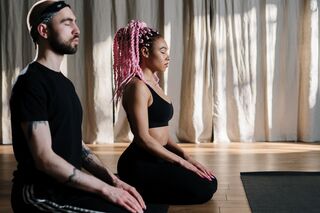Body Image
How Yoga Improves Body Image
New research explores the ways yoga can help or harm body image.
Posted June 6, 2020

The practice of yoga has been around for thousands of years, but researchers’ interest in how yoga might affect body image is relatively recent. Some evidence has shown that yoga can lead to a more positive body image. Other research has even suggested that yoga can be effectively incorporated into the treatment of eating disorders.
Researchers at Washington State University and Ohio State University recently published a new conceptual model of how the practice of yoga can create and support a positive body image. Based on dozens of studies on the topic, this model details the specific pathways through which yoga can shape your experience of your body.
The researchers focused their review on a concept called “positive embodiment.” Developed by psychologist Niva Piran, positive embodiment comprises several dimensions. It includes a feeling of comfort and ease within your body, or a sense of being “at home” in your body as you move around in the world and engage with it. Positive embodiment also involves a sense of agency — the knowledge that through your body you can have an impact on the world.
Those who experience positive embodiment tend to be in touch with their body’s desires and know how to effectively express those desires. They care for their bodies with compassion, nurture their bodies without harsh judgments, and engage in exercise that feels good.
Finally, positive embodiment involves living in your body as a subject rather than an object. In other words, you don’t accept cultural narratives that tell you your body exists simply for others to gaze at and evaluate. You reject harmful appearance norms and appreciate your body for what it does for you, not for how it looks. The authors of this new research identified several mechanisms through which practicing yoga might increase a sense of positive embodiment.
One of the most important ways the practice of yoga can promote a positive body image is by encouraging those who practice it to focus on how their body feels instead of how their body looks. Yoga teachers should encourage students to pay attention to the sensations of their bodies during yoga. Further, they should avoid drawing students’ attention to the appearance of their bodies.

Yoga may also improve body image by encouraging mindfulness. In general, mindfulness includes a nonjudgmental acceptance of and focus on the present. This way of being could extend to how yoga practitioners experience their body, leading them to be more accepting of their body and more in tune with how their body feels moment to moment.
Self-compassion is another possible mechanism through which yoga might encourage positive embodiment. In addition to mindfulness, self-compassion includes self-kindness and a sense of shared experiences with all humans. Research suggests that yoga practices that specifically develop mindfulness and self-compassion will be likely to improve body image.
The authors of this new research review identified additional mechanisms through which yoga can support positive embodiment. For example, research demonstrates that appreciating your body regardless of how it looks is a key component of positive body image. The right yoga practice can build this type of body appreciation. Yoga teachers who help students find the modifications they need for their bodies can also increase students’ feelings of bodily competence and self-efficacy, both of which are linked with a healthier body image.
Though most who practice yoga report that it improves their body image, a substantial minority of yoga practitioners report that it has harmed their body image. The authors of this new review remind readers that yoga practice can vary in key ways. In other words, not all yoga is created equal. Some approaches will encourage positive embodiment more than others.
For example, some yoga teachers create spaces that are truly welcoming to all bodies; others may send the message that yoga is only for people with certain body types (usually thin). The presence of mirrors in a yoga studio could encourage students to compare their bodies to others, which may undermine the positive effects of yoga on body image. Instructors who focus on how bodies look while practicing yoga or how yoga can alter the appearance of one’s body could have a similar negative effect. Research has suggested that yoga with a more mindful focus (i.e., attention to breathing and mindfulness) likely has more positive effects on body image than yoga focused on fitness.
Overall, a large body of research now suggests that yoga — when practiced under the right conditions — can facilitate a sense of positive embodiment. Positive embodiment feels good. On top of that, it encourages practices like intuitive eating, self-care, and exercising for enjoyment rather than from a sense of obligation. In other words, if you’re looking for a healthy way to connect with your body, give yoga a try. Just remember to keep the focus on how your body feels and what it does rather than how it looks.





